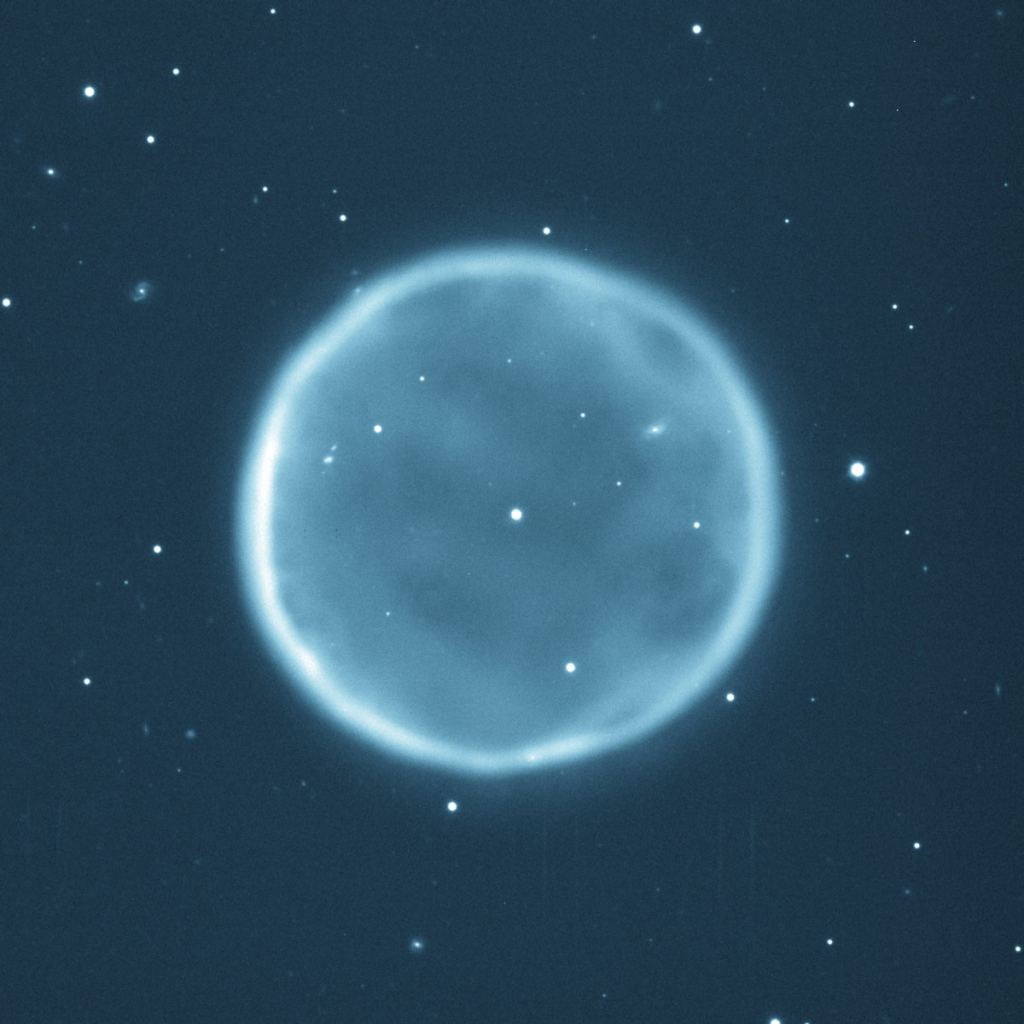Planetary nebulae are short-lived “leftovers” of sun-like stars. Most of these “star ghosts” only last—at most—about 25,000 years. Usually, their clouds of debris disperse so broadly that they fade out fairly quickly.
However, there’s one that has lasted at least 70,000 years. That makes it a “grande dame” of planetary nebulae. A team of astronomers led by members of the Laboratory for Space Research (LSR) and the Department of Physics at the University of Hong Kong spotted this rare celestial jewel in the open star cluster M37.
It orbits in our galaxy in the same galactic arm as the Sun and contains about 1,500 solar masses. The object, called IPHASX J055226. 2+323724, is the third known planetary nebula associated with an open cluster in our galaxy.
So, how do astronomers know it’s so old? Understanding this Aged Planetary Nebula A planetary nebula is a hot white dwarf star surrounded by a shell of material it ejected as it aged. In some planetary nebulae, the shell is roughly circular, while in others, it can be bi-polar-looking. The radiation from the star heats the nebula, which causes it to glow.
The age of the expanding shell might seem tough to determine. Yet, there are ways. The team that discovered this object, led by HKU’s Quentin Parker, found it has a “kinematic age” of 70,000 years.
That’s an estimate, but it’s a good one, based on how fast the nebula is expanding. The clues lie in the emission spectrum of light emitted from hot glowing gas in the expanding shell around the dying star. Those are “emission lines.
” The team also assumed the expansion speed has remained effectively the same since the beginning. Combining all that, you get the time elapsed since dying the star first ejected its outer layers. In this case, it comes to 70,000 years.
By comparison, most “typical” planetary nebulae only last about 5,000 to 25,000 years. That’s a relatively quick time, compared to the life of the star, which could have been around hundreds of millions or billions of years. The planetary nebula found in M37 (arrow points to it).
Courtesy Laboratory for Space Research (LSR) and Department of Physics at The University of Hong Kong (HKU). In addition, the fact that IPHASX J055226. 2+323724 is still visible despite its age and expanded size, makes it doubly rare.
Its location shows that it “lives on” in a relatively “safe” environment. That home in an open cluster allows the expanding gas and dust cloud to fade. If the star were in the interstellar medium, the shell could be disrupted by other influences.
Tech Talk about IPHASX J055226. 2+323724 This planetary nebula’s environment inside a stellar cluster gave the science team more insight into the original star that created the nebula. Currently, it’s a white dwarf, the aging progenitor star after it shrinks down on itself and ejects its outer layers.
It’s a very hot object that will take billions of years to cool down. When it was still a sun-like star, however, it was around 2-3 solar masses. The team was able to estimate what mass it contained when it first ejected the material that became the shell and figure out what its mass is now.
Using Gaia distance data, they also figured out that the expanding shell of material is now about 3. 2 parsecs across. (For comparison, the distance between the Sun and its nearest neighbor star, Proxima Centauri, is 1.
3 parsecs. ) That places the shell at the extremely large end of known planetary nebula sizes. Dr.
Vasiliki Fragkou, the first author of the paper describing the work on this nebula, described the open cluster- planetary nebula (OC-PN) environment as “I am so excited to be able to work on these fascinating rare cases of OC-PN associations because they keep turning up important science results, like all three cases we have found are butterfly (bi-polar) PN in terms of shape, all are very faint and highly evolved, and all have Type-I chemistry according to their emission lines, and of course, all have intermediate to high progenitor masses. ” It’s Rare but Useful Because this is only the third known example of a planetary nebula in an open star cluster in our galaxy, it provides interesting clues to the formation of the cluster where IPHASX J055226. 2+323724 lives.
Corresponding author Professor Quentin Parker pointed out that his group has found all three confirmed examples. “They are incredibly rare,” he said, “but also very important, as these beautiful objects allow us to independently determine points on the so-called initial to final mass relation (IFMR) for stars. ” Initial mass function describes the distribution of stellar masses that form in one star-forming event in a given volume in space.
It covers all stellar objects, from low-mass brown dwarfs to the most massive stars formed. It’s important in clusters as a way of understanding the range of stars they contain and, along with the existence of IPHASX J055226. 2+323724, give insight into the types of stars in M37.
For More Information Discovery of the Oldest Visible Planetary Nebula The Planetary Nebula in the 500 Myr Old Open Cluster M37 The post Astronomers Find the Oldest Planetary Nebula appeared first on Universe Today. .
From: universetoday
URL: https://www.universetoday.com/157386/astronomers-find-the-oldest-planetary-nebula/



